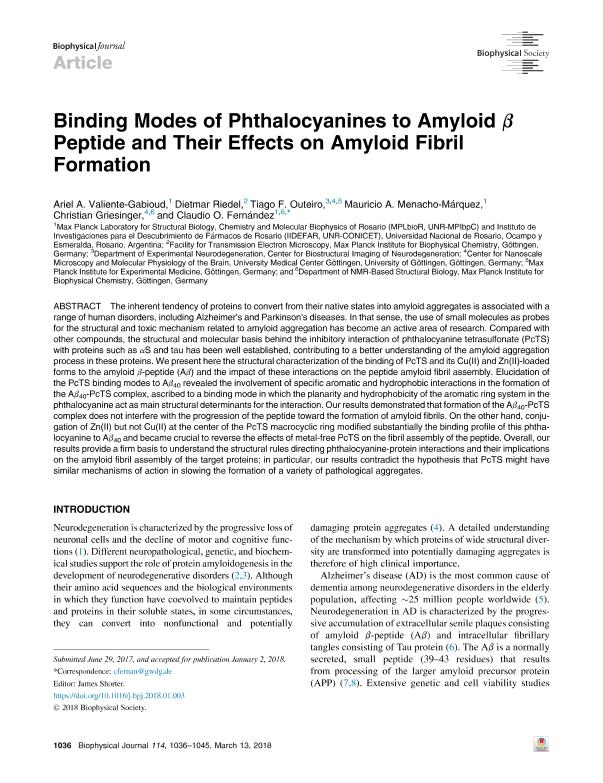Artículo
Binding Modes of Phthalocyanines to Amyloid β Peptide and Their Effects on Amyloid Fibril Formation
Valiente Gabioud, Ariel Alejandro ; Riedel, Dietmar; Outeiro, Tiago F.; Menacho Márquez, Mauricio Ariel
; Riedel, Dietmar; Outeiro, Tiago F.; Menacho Márquez, Mauricio Ariel ; Griesinger, Christian; Fernandez, Claudio Oscar
; Griesinger, Christian; Fernandez, Claudio Oscar
 ; Riedel, Dietmar; Outeiro, Tiago F.; Menacho Márquez, Mauricio Ariel
; Riedel, Dietmar; Outeiro, Tiago F.; Menacho Márquez, Mauricio Ariel ; Griesinger, Christian; Fernandez, Claudio Oscar
; Griesinger, Christian; Fernandez, Claudio Oscar
Fecha de publicación:
03/2018
Editorial:
Cell Press
Revista:
Biophysical Journal
ISSN:
0006-3495
Idioma:
Inglés
Tipo de recurso:
Artículo publicado
Clasificación temática:
Resumen
The inherent tendency of proteins to convert from their native states into amyloid aggregates is associated with a range of human disorders, including Alzheimer's and Parkinson's diseases. In that sense, the use of small molecules as probes for the structural and toxic mechanism related to amyloid aggregation has become an active area of research. Compared with other compounds, the structural and molecular basis behind the inhibitory interaction of phthalocyanine tetrasulfonate (PcTS) with proteins such as αS and tau has been well established, contributing to a better understanding of the amyloid aggregation process in these proteins. We present here the structural characterization of the binding of PcTS and its Cu(II) and Zn(II)-loaded forms to the amyloid β-peptide (Aβ) and the impact of these interactions on the peptide amyloid fibril assembly. Elucidation of the PcTS binding modes to Aβ40 revealed the involvement of specific aromatic and hydrophobic interactions in the formation of the Aβ40-PcTS complex, ascribed to a binding mode in which the planarity and hydrophobicity of the aromatic ring system in the phthalocyanine act as main structural determinants for the interaction. Our results demonstrated that formation of the Aβ40-PcTS complex does not interfere with the progression of the peptide toward the formation of amyloid fibrils. On the other hand, conjugation of Zn(II) but not Cu(II) at the center of the PcTS macrocyclic ring modified substantially the binding profile of this phthalocyanine to Aβ40 and became crucial to reverse the effects of metal-free PcTS on the fibril assembly of the peptide. Overall, our results provide a firm basis to understand the structural rules directing phthalocyanine-protein interactions and their implications on the amyloid fibril assembly of the target proteins; in particular, our results contradict the hypothesis that PcTS might have similar mechanisms of action in slowing the formation of a variety of pathological aggregates.
Palabras clave:
SMALL MOLECULES
,
INHIBITORS
,
AGGREGATION
Archivos asociados
Licencia
Identificadores
Colecciones
Articulos (IIDEFAR)
Articulos de INSTITUTO DE INVESTIGACIONES PARA EL DESCUBRIMIENTO DE FARMACOS DE ROSARIO
Articulos de INSTITUTO DE INVESTIGACIONES PARA EL DESCUBRIMIENTO DE FARMACOS DE ROSARIO
Citación
Valiente Gabioud, Ariel Alejandro; Riedel, Dietmar; Outeiro, Tiago F.; Menacho Márquez, Mauricio Ariel; Griesinger, Christian; et al.; Binding Modes of Phthalocyanines to Amyloid β Peptide and Their Effects on Amyloid Fibril Formation; Cell Press; Biophysical Journal; 114; 5; 3-2018; 1036-1045
Compartir
Altmétricas



